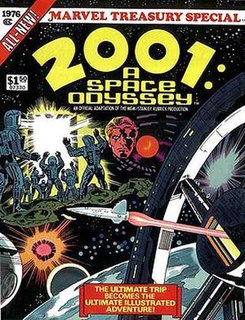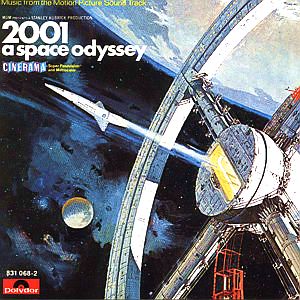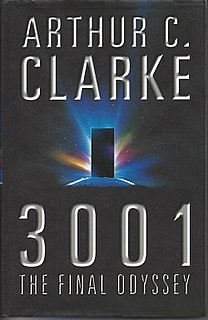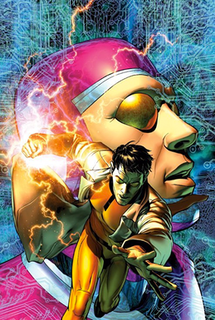 W
W2001: A Space Odyssey is a 1968 epic science fiction film produced and directed by Stanley Kubrick. The screenplay was written by Kubrick and Arthur C. Clarke, and was inspired by Clarke's 1951 short story "The Sentinel" and other short stories by Clarke. A novel released after the film's premiere was in part written concurrently with the screenplay. The film follows a voyage to Jupiter with the sentient computer HAL after the discovery of an alien monolith, and deals with themes of existentialism, human evolution, technology, artificial intelligence, and the possibility of extraterrestrial life.
 W
W2001: A Space Odyssey is an oversized American comic book adaptation of the 1968 film of the same name as well as a ten-issue monthly series which expanded upon the concepts presented in the Stanley Kubrick film and the novel by Arthur C. Clarke. Jack Kirby wrote and pencilled both the adaptation and the series, which were published by Marvel Comics beginning in 1976. The adaptation was part of the agreement of Kirby's return to Marvel.
 W
W2001: A Space Odyssey is a 1968 science fiction novel by British writer Arthur C. Clarke. It was developed concurrently with Stanley Kubrick's film version and published after the release of the film. Clarke and Kubrick worked on the book together, but eventually only Clarke ended up as the official author. The story is based in part on various short stories by Clarke, including "The Sentinel". By 1992, the novel had sold three million copies worldwide. An elaboration of Clarke and Kubrick's collaborative work on this project was made in the 1972 book The Lost Worlds of 2001.
 W
W2001: A Space Odyssey is a soundtrack album to the film of the same name, released in 1968. The soundtrack is known for its use of many classical and orchestral pieces, and credited for giving many classical pieces resurgences in popularity, such as Johann Strauss II's 1866 Blue Danube Waltz, Richard Strauss' symphonic poem Also sprach Zarathustra, and György Ligeti's Atmosphères. The soundtrack has been re-issued multiple times, including a digitally remastered version in 1996.
 W
W2010: Odyssey Two is a 1982 science fiction novel by British writer Arthur C. Clarke. It is the sequel to the 1968 novel 2001: A Space Odyssey.
 W
W2010: The Year We Make Contact is a 1984 science fiction film written, produced, shot and directed by Peter Hyams. It is a sequel to Stanley Kubrick's 1968 film 2001: A Space Odyssey and is based on Arthur C. Clarke's 1982 sequel novel, 2010: Odyssey Two. The film stars Roy Scheider, Helen Mirren, Bob Balaban and John Lithgow, along with Keir Dullea and Douglas Rain of the cast of the previous film.
 W
W2061: Odyssey Three is a science-fiction novel by the British writer Arthur C. Clarke, published in 1987. It is the third book in Clarke's Space Odyssey series series. It returns to one of the lead characters of the previous novels, Heywood Floyd, and his adventures from the 2061 return of Halley's Comet to Jupiter's moon Europa.
 W
W3001: The Final Odyssey is a 1997 science fiction novel by British writer Arthur C. Clarke. It is the fourth and final book in Clarke's Space Odyssey series.
 W
WClavius Base is a fictional lunar settlement in the Space Odyssey literary universe created by Arthur C. Clarke.
The United States Spacecraft Discovery One is a fictional spaceship featured in the first two novels of the Space Odyssey series by Arthur C. Clarke and in the films 2001: A Space Odyssey (1968) directed by Stanley Kubrick and 2010: The Year We Make Contact (1984) directed by Peter Hyams. The ship is a nuclear-powered interplanetary spaceship, crewed by two men and controlled by the AI on-board computer HAL 9000. The ship is destroyed in the second novel and makes no further appearances.
 W
WThe Lost Worlds of 2001 is a 1972 book by English writer Arthur C. Clarke, published as an accompaniment to the novel 2001: A Space Odyssey.
 W
WMachine Man is a fictional character, an android superhero appearing in American comic books published by Marvel Comics. The character was created by Jack Kirby for 2001: A Space Odyssey #8, a comic written and drawn by Kirby featuring concepts based on the eponymous 1968 Stanley Kubrick feature film and Arthur C. Clarke's 1968 novel. Shortly thereafter, Machine Man spun off into his own Kirby-created series. He is a robot, the only survivor of a series, raised as a human son of scientist Abel Stack, who was killed removing his auto-destruct mechanism, and further evolved to sentience by a Monolith.
 W
WIn Arthur C. Clarke's Space Odyssey, Monoliths are machines built by an unseen extraterrestrial species. In the series of novels, three Monoliths are discovered in the Solar System by hominids and humans. The response of the characters to their discovery drives the plot of the series. It also influences the fictional history of the series, particularly by encouraging humankind to progress with technological development and space travel.
 W
WPoole vs. HAL 9000 is a chess game depicted in the 1968 science fiction film 2001: A Space Odyssey. Astronaut Frank Poole (White) plays the supercomputer HAL 9000 (Black) using a video screen as a chessboard. Each player takes two turns during a game in progress, making their moves orally using descriptive notation and natural language. Poole resigns the game once HAL indicates a certain path to checkmate, however the move which HAL suggests Frank might make is not forced. Stanley Kubrick, director of 2001, was an avid chess player.
 W
WThe 1968 science fiction film 2001: A Space Odyssey featured numerous fictional future technologies, which have proven prescient in light of subsequent developments around the world. Before the film's production began, director Stanley Kubrick sought technical advice from over fifty organizations, and a number of them submitted their ideas to Kubrick of what kind of products might be seen in a movie set in the year 2001. The film is also praised for its accurate portrayal of spaceflight and vacuum.
 W
WThe Toynbee tiles are messages of unknown origin found embedded in asphalt of streets in about two dozen major cities in the United States and four South American cities. Since the 1980s, several hundred tiles have been discovered. They are generally about the size of an American license plate, but sometimes considerably larger. They contain some variation of the following inscription: